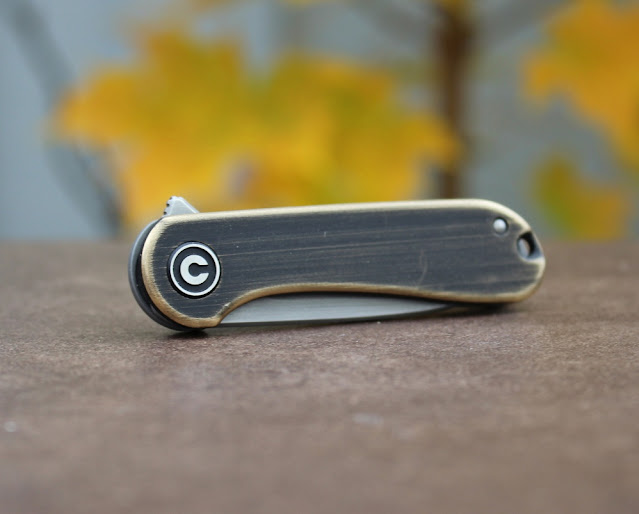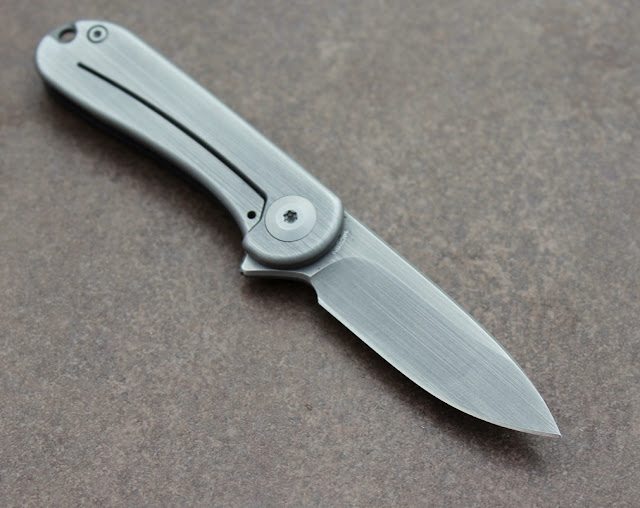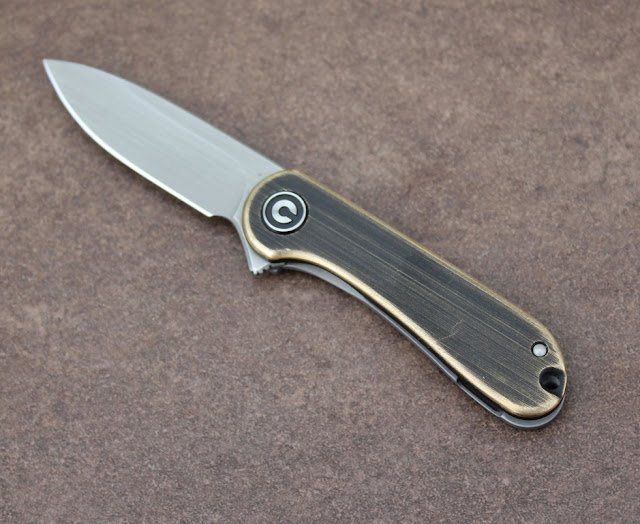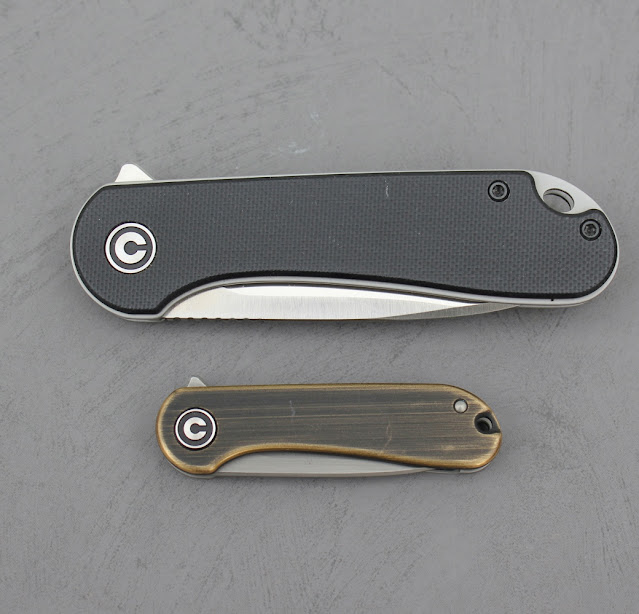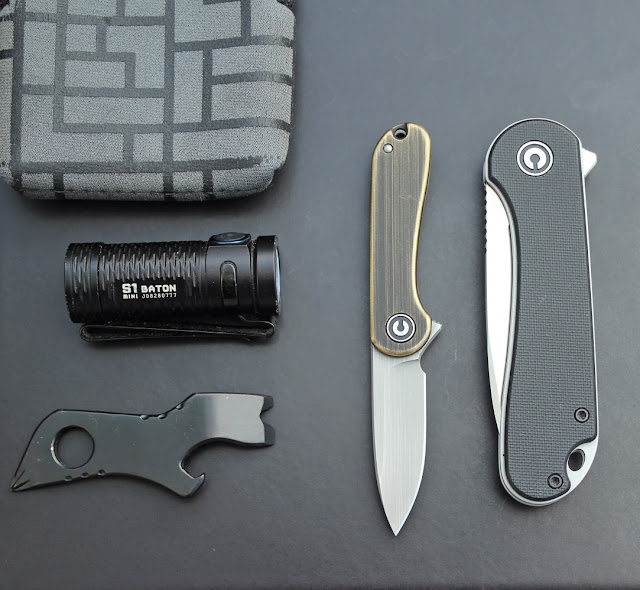 |
| SOG Aegis AT |
To emphasize that this is not a "tactical" knife aimed at the police and military, this model is equipped with rather cheerful color combinations. They are called things like "indigo & acid", "rescue red" or in this case "tan & blaze". A color combination that otherwise usually can not be bought in Europe but is intended for the North American market. I have no idea why they chose to do it that way. Otherwise, Aegis AT is available in at least eight versions at this time, some of which are equipped with Tanto blades for those who prefer it. There is also an entry-level model called
Aegis FLK.
 |
| Aegis in the colors "tan & blaze" including a blackened blade |
Twitter version: SOG Aegis AT, a very good folding knife for outdoor use that could have been even better.
Blade
The blade feels quite hefty. Not that it is excessively thick, the stock thickness is a modest 3 mm. The blade isn't very long either as the length is just under eight centimeters. However, it is quite high with its three centimeters. This is what makes it feel sturdy.
The shape is a quintessential drop point. One of the best options for this type of knife and here in a design that is excellent in terms of proportions.
Some people say that SOG writes too much on their blades. Personally, I think it depends more on how you do it than what is printed there. In this case quite a lot of information, but in return, it's only found on one side and in a not too conspicuous format. The other is completely sterile. On the presentation side, the entire abbreviation can be read besides the model name and steel type. There you will also find out how the steel is hardened.
 |
| An ingeniously simple drop point blade |
This means that it is "cryo" -treated. In all simplicity, a procedure that involves cooling the blade to low temperatures during hardening. If it is preferable to all other methods, I can not comment on it, but there are a number of manufacturers who successfully use that method.
The steel that has received that treatment is D2 in some form. I say so because D2 is the term for a group of tool steels that are not completely in unison with each other, even though of course they have a similar composition. In general, they provide good properties for knives to be used outdoors. It takes a good edge and holds it well while it is tough.
One drawback with D2 steel is its corrosion resistance. Or rather the lack thereof. Put simply, it tends to rust. Here, SOG went for a solid coating of titanium nitride to avoid it. The black coating has proven more durable than the gold-toned variant found on Terminus LTE. It got stains almost immediately and that does not apply in this case. In addition, it fulfills its function. Despite the humid autumn, the blade has not shown any discoloration or rust.
 |
| Stålet är D2 med beläggning för att skydda mot korrosion |
|
The blade bites as well. Everyday materials such as cardboard and plastic are handled with ease. A flat-ground blade with a good edge is the reason why. The factory edge was well made, both symmetrical, even in height, and sharp. Then SOG obviously knows how to make a proper "sharpening choil". This is how you do it! Look at the picture above and you will see what I mean. No problem sharpening this blade in the future.
The tip is also quite capable and puncturing packaging such as shrink plastic and the like does not pose any problems. It is also easy to "find". By that, I mean that it feels like a natural part of the hand when you have to poke something. The tip is thin but can withstand some lateral abuse. It has been tested by jamming the knife in my throwing targets and then prying the knife loose again.
But above all, the knife actually works well in the forest. There, Aegis has been tested on wood of various kinds, both dry wood and fresh branches and also nylon and hemp rope. After cutting some of the latter, it can be said that the edge holds well but that it is not super steel. But in return, it responds well to a few strokes on a leather strop. Then this knife has the positive property that it is easy to position your hand forward on the handle and thus get close to what you are cutting. More power when you carve in other words. For that, the edge angle is also decent. Without being a mora knife, you still get good control when cutting. But you do not get the same solid chips as with a scandi-grind blade. After all, this is a folding knife. However, a good one with a very good blade.
Handle
Aegis AT belongs to those knives with a strange imbalance between the blade and handle. As I said, the blade measures in at just under eight centimeters, while the handle is a full 12.7 cm long. There is a noticeable gap there. However, there are advantages to this way of doing things. Firstly, there is room for large hands and secondly, you can work with gloves on if needed. The handle is also thick, measuring 1.5 cm across. It fills the hand well, especially for those who have large paws.
But designing a knife in this way is not entirely problem-free, especially if you build it on a steel frame. With such a long handle, the knife becomes quite handle-heavy, even though the backspacer is made of plastic. The balance point is located just behind the locking bolt on the Aegis. It's more than two centimeters further back in relation to where I'd wanted to see it.
 |
| The handle is large and spacious made by GRN |
The material on the sides is "GRN" which is one of many fiber-reinforced nylon materials available on the market under various names. In this case, it is fiberglass that is involved. It provides a strong and durable handle that handles cold, heat, and abrasion relatively well. However, it cannot be compared with, for example, the G10 when it comes to the latter.
The handle sides have two different patterns. One to mark the beveled parts at the index finger groove and one for the rest of the handle. It gives a little texture but not as much as I wanted to see on this type of knife. There are some grooves on the top of the handle that extend a bit out on the blade for a slightly better grip. But I'm glad that they did not provide the knife with more of that kind. I sometimes want some grip, but from the shape of the handle, not due to artificial additions. I do not like knives that feel like gripping a sea urchin no matter how well they sit in your hand.
 |
| Aegis is partially open in the back but there is both a small backspacer and an extra lock |
The base of the handle consists of a steel frame. It is not very weight relieved, there are two holes, one per side but no more. The sides are then screwed on the outside of the frame with three screws through the small but colorful backspacer. They are the ones who together with the pivot screw hold the knife together. The size of the screws is consistent which is good. Less good is that they chose to keep the size of all to minimal T6 heads. It feels strange on an otherwise very sturdy knife.
The backspacer extends beyond the handle and includes a lanyard hole. This solution makes it easy to access but is, among other things, a tributing factor to the disproportionately long handle.
 |
| In the hand, the Aegis is very good and the handle is long enough so that the protruding backspacer does not cause hotspots |
In hand, Aegis is a pleasant acquaintance and so is working with it. The knife is thus ergonomically sound. The width gives more contact surface against the hand and the length makes it easy to adjust the grip. The groove available for the index finger does not lock the hand but makes the grip more secure.
The fairly simple shape makes it easy to change grips when needed. Particularly sympathetic is the knife in a hammer grip and reverse grip. Excellent when you cut wood and need some power. The only downside is that the extra lock is of course felt against the hand if you hold the handle tightly. I do not know why so many manufacturers assume that you should always work with a thumb on the back of the handle or blade? It is good for lighter chores but does not work otherwise. Apparently, you do not cut wood in the USA. But it is not unique to SOG.
Opening and Lock
One thing that surprised me when I first got this knife in my hand and that is how it opens. The thumb studs are hard to miss as they, together with the backspacer and lock functions, have been given an accent color. So the surprise was not really how but more the feel. The knife offers a strong feather kick when the blade is partially open. Aegis AT is thus assisted. Slightly unclear why but that is the case.
 |
| The brightly colored thumb studs on this specimen are hard to miss. They also work well |
In addition, it is a fairly strong spring. The function itself is good. The classically shaped thumb studs are placed correctly and are easy to access, but due to the resistance, you have to use some force before anything happens. Then the blade really flies out. The reason why you must use more strength than usual is due to the spring also acting as a "detent". It ensures that the blade is kept in place in the retracted position.
The combination of the spring and the type of lock means that this knife must in principle be closed with two hands. Alternatively, you must be acrobatic and pull the lock bar backward while pulling the knife towards the leg or other surface. Elaborate and impractical but doable.
 |
| There are plenty of locks on this knife. One on the back of the handle that ensures that the knife can not be opened accidentally and SOG's excellent XR lock which is one of the better cross-bolt locks on the market |
The lock is SOG's own version of a cross-bolt construction called "XR Lock". Here they added the suffix "AT". I do not know what it stands for. Maybe it has to do with the extra lock. The one I never use as it is completely meaningless. In this case, it is not like many other solutions to reinforce the existing lock and prevent it from disengaging. That's good before it's surely not needed. The XR lock is more than secure, it holds the blade rock hard. SOG claims that the lock can hold 1500 pounds. It's more than I've tried but I've never noticed any tendency for it to fail which is good enough. The blade does not suffer from any play either, so I am very happy with the function.
The extra lock is for preventing the knife from being unintentionally opened. Something that is hardly possible with the strong spring resistance. To use the function, you must also open the knife with two movements instead of one because the actuation button is located on the spine of the handle. First, you have to push it forward, preferably with your thumb to release the lock, and then angle the knife on the side to reach the thumb studs to be able to let the blade fly.
Att bära
I can put it like this, Aegis is a tangible knife. It is not a disaster to carry but the things I listed when I wrote about the handle are also relevant under this heading. It can be summed up as being a voluminous handle. It is both long and thick. However, the knife is actually not excessively high so the profile is not too bad.
 |
| SOG offers a good clip, not as fully advertising-heavy as they can be but why the huge screw heads? |
Nor is the weight extreme with its 127 grams. It is, after all, a sturdy knife we are talking about. In the same way, the smooth material in the handle helps in an excellent way when it comes to pulling the knife in or out of a pocket. The thumb studs do not protrude so far that they get stuck in anything and the sides are fairly slick. It is especially nice that they are not abrasive where the clip comes into contact with the handle.
 |
| The clip could be of the deep ride type if it were not for the screws. |
The clip is both good and bad. The shape is excellent with just the right height to hold fabric, a good ramp for getting over fabric edges while not pointing outwards, which has a positive effect on ergonomics. The rear edge does not cause problems either, as the handle is so long that this possible source of discomfort can be ruled out. The clip is also removable, which of course is a plus, at least for left-handers.
But then there were the screws. What are they doing there? The clip is not recessed on the handle side and neither are the screw heads. They are also round and tall. They are thus stealing half of the space I just praised above. So what's the point of a good design to begin with? This clip is thus clumsy to use together with pants and jackets where the edges of the fabric are a little sturdier. Something that is typical of just clothing items aimed at outdoor life. The area for which this knife is also intended.
To Conclude
Aegis AT is a knife that I generally like but which could have been significantly better in some respects. The blade is excellent and the handle comfortable. Two of the most important properties ticked off the list of desirable properties for a folding knife intended for outdoor life.
SOG calls this knife the "perfect companion for outdoor use". They mention activities such as hiking, camping, and hunting in their promotion text. However, I would not do the latter with this kind of knife. I have no problem seeing that the blade would be excellent for such tasks. But a knife with a handle full of small nooks and crannies caused by details such as a lock with associated small springs, an extra safety feature on the back and not to forget another spring to accelerate the blade. That is not a handle I would like blood, hair, and remnants of intestines in. For the same reason, the knife is unusually difficult to clean by disassembly for those who are interested in such. SOGs seem to be aware of this since they have provided the knife with very small screw heads which in the long run will not withstand that treatment in any case.
For those reasons, Aegis AT is in my eyes, not a suitable hunting or fishing knife. Of course, you can use it for that, it is a competent tool if it is the only one available but there are much more appropriate knives. On the other hand, it is a good knife for outdoor life, whether you move by canoe, bicycle or on foot and spend time camping, car-camping or traveling by boat. It is solid and reliable.
 |
| Aegis is a really nice knife that would have looked even better if it had been better balanced |
Then it can be discussed whether the materials correspond to the price tag. GRN or fiberglass-reinforced nylon is really not a bad material, that's not what I mean, but it's certainly not exclusive either. The same applies to the choice of steel. D2 is something that is available on low-budget knives and Aegis does not belong in that category.
But a knife is more than the sum of the constituent materials. A proverb that may not exist but should exist. Because in this case, the D2 steel is well treated what it seems. It maintains sharpness well while being easy to hone and sharpen. Part of the explanation may be found in the "cryo" treatment. The steel has also been given a good and durable coating to better protect against corrosion. This means that you have stretched about as far as you can with that material.
The choice of a nylon handle can be discussed a bit more. I would have liked to have seen the knife in, for example, Micarta or at least the G10 for that price. Not because it makes an extremely big difference in performance. But Micarta is just as durable and superior in appearance. G10 is stronger than both of them and provides a better grip than the GRN does. Especially in this embodiment.
Personally, I also think that a few changes in the design and construction itself would have made the knife better. In addition to another material in the sides, I had shortened the handle by changing the design of the lanyard hole. By the way, such a large folding knife does not need any. What is it used for? It seems to be there because some individuals on the internet require one. Such a large knife should not be fished out of a pocket, the handle certainly does not need to be extended and you do not chop wood with a folder so the knife risks flying out of your hand. This only leaves if you were to use the knife close to the water and don't want to drop it to justify the existence of a lanyard hole.
But more importantly, I had skipped the extra lock and above all the spring assistance that is the origin of it. Those functions only complicate the knife and make production more expensive and make cleaning more complicated. Instead, putting the money on materials is my suggestion and two of the problems will be solved in one go.
Then I do not understand why you make an otherwise good clip but forget the screws? They steal half of the available space under the clip and make it less compatible with thicker fabrics in, for example, winter clothes. The reason for the larger handle was, among other things, the use of gloves, so here I would have liked more consistency in thinking.
 |
| SOG Aegis AT is a solid and reliable folding knife well suited for outdoor life |
All in all, I would therefore like to say that SOG Aegis is certainly a good folding knife for outdoor use, but not quite as all-round as the manufacturer wants to claim.
However, it could be. As it is now, however, I can still recommend it. The solid construction including a strong lock together with the sturdy handle and a good blade gives plenty of power to put behind the cuts. This makes Aegis a folding knife that is unusually good to tackle, for example, wood and thick rope. Typical materials to handle when out in the woods. Due to the blade geometry, Aegis is quite suitable for outdoor cooking as long as you keep the ingredients away from the handle. So the knife has its merits and apart from a lack of balance, it does not look so tedious either.
Specification:
Length Overall: 207 mm
Length Folded: 12,7 mm
Weight: 127 g (weighed by me)
Blade Length: 79,5 mm
Blade Thickness: 3 mm
Blade Steel: D2
Hande: GRN
Lock: AT-XR
Produced by: SOG, made in Taiwan
/ J





















